Status Under construction Cost 20 billion USD | Estimated completion 2015–24 Groundbreaking 4 December 2012 | |
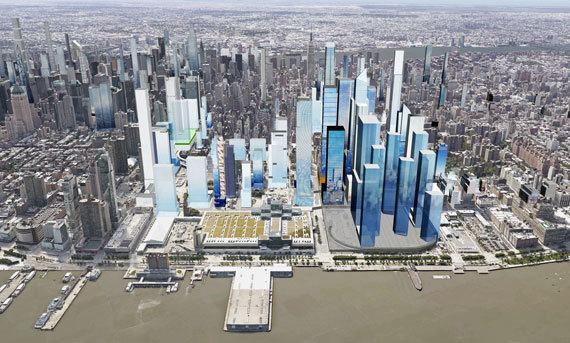 | ||
Location Bounded by 30th Street, Twelfth Avenue, 34th Street, and Tenth AvenueManhattan, New York City Architect Kohn Pederson Fox (master planner)Skidmore, Owings & MerrillTutor Perini Building Corp. (contractor) Developer The Related Companies L.P.Oxford Properties Group Inc.Collingwood Inc. | ||
Hudson Yards is a large-scale redevelopment program that is planned, funded and constructed under a set of agreements among the City of New York, the State of New York, and the Metropolitan Transportation Authority, with the aim of expanding the Midtown Manhattan Business District westward to the Hudson River. The program includes a major rezoning of the Far West Side, an extension of the New York City Subway's 7 <7> trains to a new subway station at 34th Street and 11th Avenue, a renovation and expansion of the Jacob K. Javits Convention Center, and a financing plan to fund the various components.
Contents
- Redevelopment planning
- Rail yard development
- Financing
- Subway extension
- Parks
- Associated development
- Rail yard construction
- Phase 1
- Phase 2
- Technological advances
- List of buildings
- References
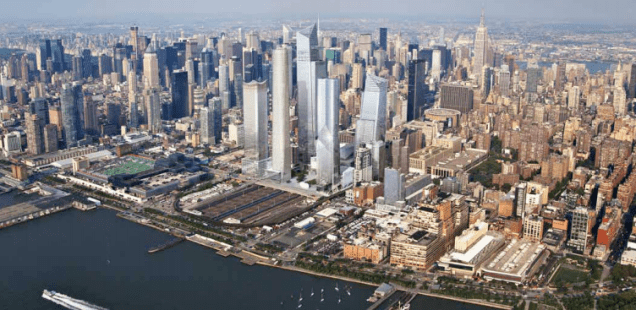
The centerpiece of Hudson Yards is a 28-acre (11 ha) mixed-use real estate development of the same name by Related Companies and Oxford Properties, currently being constructed over the West Side Rail Yard. This new construction project is the largest of its kind. According to its master plan, created by Kohn Pedersen Fox Associates, Hudson Yards is expected to consist of 16 skyscrapers containing more than 12,700,000 square feet (1,180,000 m2) of new office, residential, and retail space. Among its components will be six million square feet (560,000 m2) of commercial office space, a 750,000-square-foot (70,000 m2) retail center with two levels of restaurants, cafes, markets and bars, a hotel, a cultural space, about 5,000 residences, a 750-seat school, and 14 acres (5.7 ha) of public open space. The railyard project broke ground on December 4, 2012; the first tower, an 895-foot (273 m) office building in the southeast corner of the site, opened on May 31, 2016. The over-US$20 billion development will accommodate a projected 65,000 daily visitors when completed.
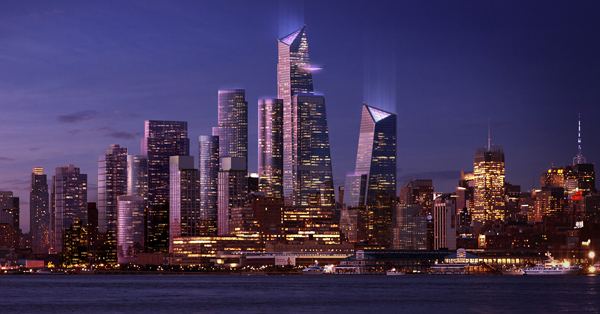
Redevelopment planning
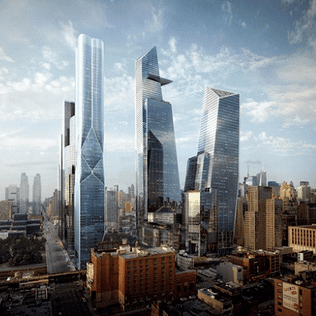
The Hudson Yards area is bordered on the east by Seventh and Eighth Avenues, on the south by West 28th and 30th Streets, on the north by West 43rd Street, and on the west by Hudson River Park and the Hudson River. In 2003 the New York City Department of City Planning issued a master plan that envisioned the creation of 40 million square feet of commercial and residential development, two corridors of open space – one between Eleventh Avenue and Tenth Avenue, and another network of open space between Ninth Avenue and Tenth Avenue to create a park system from West 39th Street to West 34th Street, portions of which would be located along the Dyer Avenue/Lincoln Tunnel Expressway corridors. The City's plan was similar to a neighborhood plan produced by architect Meta Brunzema and environmental planner Daniel Gutman for the Hell's Kitchen Neighborhood Association (HKNA). The main concept of the HKNA plan was to allow major new development while protecting the existing residential core area between Ninth and Tenth avenues.
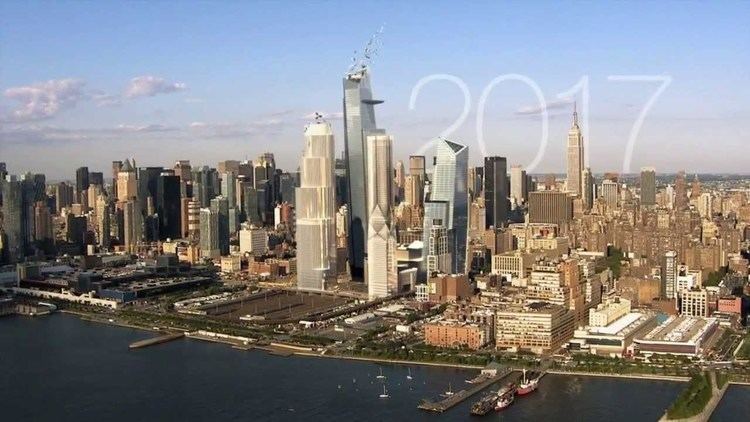
To help facilitate development, the City's plan called for an extension of the 7 <7> trains to a 34th Street subway station under Eleventh Avenue, adjacent to the Jacob K. Javits Convention Center. To fund the subway and and a park and boulevard and other infrastructure, the City proposed a novel tax-increment financing scheme within a Hudson Yards financing district to collect both residential property taxes and commercial payments-in-lieu-of-taxes (PILOTS) and sell transferable development rights to prospective developers. A Hudson Yards Infrastructure Corporation would issue bonds against expected revenues.
In January 2005, the New York City Council approved the 60-block rezoning, including the eastern portion of the West Side Yard. The newly rezoned Hudson Yards area was to have 25,800,000 square feet (2,400,000 m2) of Class A office space, 20,000 housing units, two million square feet (190,000 m2) of hotel space, a 750-seat public school, one million square feet (93,000 m2) of retail and more than 20 acres (8 ha) of public open space. The rezoning and financing district did not include the western portion of the rail yard, which was reserved for the proposed West Side Stadium, to be built for the New York Jets and New York City bid for the 2012 Summer Olympics. In June 2005, the stadium proposal was defeated. After the City rezoned the western rail yard and added it to the financing district, the Metropolitan Transportation Authority (MTA) sought to develop the 26-acre (11 ha) yard. In conjunction with the City the MTA issued a Request for Proposal (RFP) for a 12,700,000 square feet (1,180,000 m2) mixed-use development to be built on platforms over the rail yard, which would remain in use throughout.
Rail yard development
Five developers responded to the RFP: Extell, Tishman Speyer, Brookfield, Vornado, and the Related Companies. Tishman Speyer won the bid in March 2008. Tishman Speyer entered into a 99-year lease with the MTA, paying $1 billion for the air rights. It would also spend another $2 billion for development over the rail yards, including for the two platforms over the yards to support 15 acres (6.1 ha) of public spaces, four office buildings, and ten high-rise residential towers.
However, just two months later, the deal broke down due to the late-2000s financial crisis. Not much later, the MTA chose the Related Companies and Goldman Sachs to develop Hudson Yards under the same conditions. In December 2009, the New York City Council approved Related Companies' revised plan for Hudson Yards, and the western portion of the West Side Yard was rezoned. Following the rail yards' successful rezoning, the MTA signed another 99-year lease to the air rights over the rail yard in May 2010. The air rights were signed over to a joint venture of Related Companies and Oxford Properties Group, which invested $400 million to build a platform above both the eastern and western portions of the yard on which to construct the buildings. Groundbreaking for 10 Hudson Yards, the first building, occurred on December 4, 2012.
In April 2013, the Related/Oxford joint venture obtained a $475 million construction loan from parties including Barry Sternlicht's Starwood Capital Group and luxury retailer Coach. The financing deal was unique in several aspects, including the fact that it included a construction mezzanine loan, that Coach was a lender on both the debt and equity sides, and that the MTA helped create the "severable lease" structure that allowed for the loans. A portion of the project has also been financed by the EB-5 investment program, which uses capital from immigrants who become eligible for a green card.
Financing
The city had originally projected to receive $563 million from property sales by September 2015, but only half the amount came in. Consequently, the city has had to allocate $358 million since 2006 to pay off debt. But developers have paid the city $336 million since July 2014, twice the debt service during that period. The pace has quickened in recent years, with 57 buildings built or under construction in the area from 2006 to June 2015, indicating an improving balance sheet.
Subway extension
After the Hudson Yards project was approved in 2005, the MTA received proceeds from the initial 2006 bond offering to pay for the subway to 34th Street. With funding assured, the MTA proceeded quickly to construction. The subway extension opened on September 13, 2015, and connects to nearby buildings and developments, including 30 Hudson Yards and the Hudson Park and Boulevard. The 34th Street station's main entrance, escalators and an elevator on the west side of Hudson Park and Boulevard between 33rd and 34th Streets, is at the foot of 55 Hudson Yards and is just half a block away from the rail yard's northern edge. Another station, planned for Tenth Avenue and 41st Street, was not built.
Parks
Hudson Boulevard and Park, a four-acre system of parks and roads, is located north of the rail yard site, extending from 33rd Street to 39th Street, mid-block between Tenth Avenue and Eleventh Avenue. The boulevard is divided into a Hudson Boulevard East and a Hudson Boulevard West, with the park between the two. The first phase, between 33rd and 36th Streets, was completed in August 2015. Proposed parks between Ninth and Tenth avenues in the original plan were later dropped.
In late 2014, the final phase of the High Line, an elevated park using the former right-of-way of the southern portion of the West Side Line, opened. It enters the Hudson Yards site and curves along 30th Street, Twelfth Avenue and 34th Street, with a spur (dubbed "The Spur") along 30th Street to Tenth Avenue. Related Companies intends to integrate the High Line with its buildings; for example, 10 Hudson Yards cantilevers over The Spur. Dubbed "High Line at the Rail Yards", the section will be built in three phases. The right-of-way from 30th Street will be extended into the Hudson Yards site, running parallel to 30th Street past Eleventh Avenue, and developed in a manner similar to the opened sections of the park. The Spur along 30th Street is slated to get an amphitheater, restrooms, trees and grasses above Tenth Avenue. Finally, the curved section around the western part of Hudson Yards will be developed as an "interim walkway", with further construction in 2015.
Associated development
Even before the opening of any of the rail yard buildings, many businesses in the area have seen increased profits due to the project's construction. The Hudson Yards redevelopment program catalyzed plans to build new buildings along the future Hudson Boulevard. There has also been a development boom in the vicinity of the rail yard development. Among these are 3 Hudson Boulevard (formerly the GiraSole), located on 34th Street and Eleventh Avenue.
Related Companies seeks to build two new office buildings, neither of which were originally part of the Hudson Yards' original design concept, north of the site, including on the footprint of the current headquarters of Coach, Inc.. These towers are tentatively known as 50 Hudson Yards and 55 Hudson Yards. The 55 Hudson Yards building will start construction in January 2015, and it is expected to be opened by late 2017, finishing earlier than 30 and 35 Hudson Yards. On the east side of Tenth Avenue in Manhattan West, where Brookfield Properties announced its intent to develop over the trackage that leads to the New York Penn Station. To facilitate construction and to build a public plaza, Brookfield Properties announced that it would use prefabricated parts to build a platform, over which its two office towers would rest upon and over which a public plaza would be built.
In early 2014, real estate firm Massey Knakal announced a conceptual supertall with a 1.22 million square feet capacity and 108 stories that would soar over 1,800 feet on the north side of 34th Street between Hudson Boulevard and Tenth Avenue in order to show the potential of a site that it intended to sell. Dubbed Hudson Spire and designed by MJM+A architects, it would be the tallest tower in the Western Hemisphere if completed. The site was later purchased by Tishman Speyer on April 30, 2014, along with two adjacent properties for a total space of 2,850,000 square feet (265,000 m2).
In February 2015, the Chetrit Group, headed by Meyer and Joseph Chetrit, announced that it wanted to spend US$29 million to expand one Hudson Yards development site to 373,068 square feet (34,659.2 m2). It would add about 200,000 square feet (19,000 m2) of space to a site between 11th Avenue, 37th and 38th Streets, and Hudson Boulevard that previously allowed 173,000 square feet (16,100 m2) of retail space. A buyer would be able to split the space between two buildings.
In June 2015, Tishman Speyer bought another lot between West 36th and 37th Streets on 11th Avenue; the lot was zoned for a 735,000 square feet (68,300 m2) residential and hotel property. It is next to a lot—zoned for a planned residential tower—that was bought in 2012 by Lalezarian Properties for $46.5 million, Tishman Speyer's land is also close to a lot owned by former New York Governor Eliot Spitzer, who bought the lot in 2013 and plans at least 414,000 square feet (38,500 m2) of new development space.
Rail yard construction
The new platform upon which the Hudson Yards development will be built is bordered by 10th and 12th Avenues and by 30th and 33rd Streets. It is expected to cost more than US$20 billion and may eventually see 65,000 visitors a day. As of June 2015, construction is overseen by Related Companies' executive vice president, Timur Galen.
The 26.17-acre (10.59 ha) Hudson Yards project, the largest planned development ever built in the United States, was to be constructed over the existing at-grade West Side Yard, allowing LIRR trains to continue to be stored during midday hours. The land parcel is bordered by 30th Street and Chelsea on the south, Twelfth Avenue on the west, 33rd Street and Hell's Kitchen on the north, and Tenth Avenue on the east. Eleventh Avenue runs through the site, and splits the redevelopment project into two phases. To minimize construction impact on the LIRR's ability to store trains during midday and peak hours, caissons were drilled into bedrock throughout much of the site, over which the platform was to be built. However, only 38% of the ground level at West Side Yard was to be filled in with columns to support the development. Much of the platform itself will be built by a huge Manitowoc 18000 crane. The eastern platform, supporting the towers, comprises 16 bridges. The platform for the Eastern Rail Yard was completed in October 2015, and the western platform will be completed by 2016.
In 2013, Amtrak announced it would build a "tunnel box" through the project areas to reserve the space for a future rail right-of-way such as the proposed Gateway Project. Construction began September 2013 and is expected to take two years. The underground concrete casing is 800 ft (240 m) long, 50 ft (15 m) wide, and approximately 35 ft (11 m) tall.
Phase 1
Phase 1, the eastern phase, is to contain two office towers on Tenth Avenue, plus a retail podium between them. The southern tower, the 52-story, 895-foot (273 m) 10 Hudson Yards, opened in 2016, anchored by Coach Inc. The building, for which ground was broken on December 4, 2012, was the first of the Hudson Yards buildings to begin construction, because it is not being built over railroad tracks. It will, however, straddle the High Line spur to Tenth Avenue. 10 Hudson Yards, which opened on May 31, 2016, is expected to receive LEED Gold certification, as all of the other Phase 1 buildings. The other tower, the 80-story, 1,337-foot (408 m) 30 Hudson Yards, is designed by Kohn Pederson Fox with an observation deck. Construction will begin after caissons are sunk to support the platform over the tracks, the latter of which will be raised 12 to 27 feet (4 to 8 m) above ground level and be level with the High Line. Related Companies officials expect 30 Hudson Yards to be occupied by 2018.
Bordering Eleventh Avenue are two mixed-use buildings, 15 Hudson Yards and 35 Hudson Yards, which were previously known as the D and E Towers, respectively. 15 Hudson Yards will be connected to a semi-permanent structure, a performance and arts space known as the Culture Shed. 15 Hudson Yards started construction in December 2014, and construction on 35 Hudson Yards's foundation was started in January 2015.
In Phase 1, there will also be 100 shops and 20 restaurants inside a proposed 7-story mall, which will have 1,000,000 square feet (93,000 m2) of space, including 750,000 square feet (70,000 m2) in retail, possibly including department stores and a movie theater. The retail space, designed by Elkus Manfredi Architects with a connection to the bases of 10 and 30 Hudson Yards, started construction in June 2015, with a 100,000 short tons (91,000,000 kg) order of steel, one of the largest such orders in the history of the United States. In September 2014, Neiman Marcus was signed to become the anchor tenant of the Hudson Yards Retail Space, which will open in 2018; the store will occupy the top 3 levels and 1⁄4 of the mall, or 250,000 square feet (23,000 m2). Fairway, a locally based grocer, is expected to build a store in the lower floors of the building, occupying 45,875 square feet (4,262 m2). Chef and restaurateur Thomas Keller will open a restaurant in the complex, in addition to selecting 11 other restaurants in the retail space; all 12 restaurants are expected to open in 2018. The mall may be anchored by Dior and Chanel on the topmost floors, with "a 'Fifth Avenue' mix of shops", such as H&M, Zara, and Sephora below them.
There will also be a 6-acre (2 ha) public square, with 28,000 plants and 225 trees, on the platform. The square's architecture was conceived by Nelson Byrd Woltz and Heatherwick Studios. The plaza's southern side will have a canopy of trees. The southeast entrance will contain a fountain as well. A "'seasonally expressive' entry garden" will be located at the subway entrance at 33rd Street. In the middle of the square would be a 16-story structure of connected staircases between the buildings; the structure, titled "Vessel". is designed by Thomas Heatherwick and will cost US$150 million. "Vessel"—which has 154 staircases, 2,500 steps, and 80 landings that stretch from its 50-foot-wide (15 m) base to its 150-foot-wide (46 m) apex—would be able to hold up to 1,000 people at a time. The public square will be a ventilation area for the West Side Yards, as well as a storm water runoff site. Storm water that runs off into the square will be reused. Since it is going to be on top of an active rail yard, the public square would be located over a 6-foot (1.8 m) deep plenum above a huge cooling slab with 15 fans blowing 45 miles per hour (72 km/h) air and a 60,000-US-gallon (230,000 l; 50,000 imp gal) rainwater storage tank. The whole platform would then be supported by 234 caissons. The plantings themselves would be rooted with "smart soil".
Phase 2
The western phase of the project is to contain up to seven residential towers, an office building at 33rd Street and Eleventh Avenue tentatively known as "West Tower", and a school serving Pre-K to eighth grade students. The third phase of the High Line will traverse Phase 2 of the project. The entire project, including Phase 2, could be complete by 2024.
Technological advances
The rail yard development will be technologically advanced, in that all sorts of data will be collected within the buildings using sensors and other data-collecting instruments. Among the innovations will be:
New York University's Center for Urban Science and Progress is designing the infrastructure with the developers of Hudson Yards. Fiber loops connected to satellite dishes on rooftops, to transponders, and to two-way radios will create a network covering the 14 acres (6 ha) of open space as well as 17,000,000 square feet (1,600,000 m2) of commercial space. The technology is designed to be adaptable — updates to infrastructure will be performed as new technological advances are made.
List of buildings
Below is a list of buildings constructed, planned, or proposed for the broader Hudson Yards neighborhood (from Northwest to Southeast):
